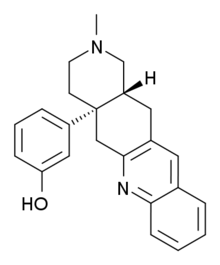TAN-67
 | |
| Identifiers | |
|---|---|
| |
| CAS Number | 148545-09-9 |
| PubChem (CID) | 9950038 |
| ChemSpider | 8125649 |
| KEGG | C20168 |
| ChEMBL | CHEMBL327745 |
| Chemical and physical data | |
| Formula | C23H24N3O |
| Molar mass | 344.449 g/mol |
| 3D model (Jmol) | Interactive image |
| |
| |
| (verify) | |
TAN-67 (SB-205,607) is a opioid drug used in scientific research that acts as a potent and selective δ-opioid agonist,[1] selective for the δ1 subtype.[2] It has analgesic properties[3][4] and induces dopamine release in nucleus accumbens.[5] It also protects both heart and brain tissue from hypoxic tissue damage through multiple mechanisms involving among others an interaction between δ receptors and mitochondrial K(ATP) channels.[6][7][8][9][10]
References
- ↑ Fujii H, Kawai K, Kawamura K, Mizusuna A, Onoda Y, Murachi M, Tanaka T, Endoh T, Nagase H. Synthesis of optically active TAN-67, a highly selective delta opioid receptor agonist, and investigation of its pharmacological properties. Drug Design and Discovery. 2001;17(4):325-30. PMID 11765135
- ↑ Nagase H, Kawai K, Hayakawa J, Wakita H, Mizusuna A, Matsuura H, Tajima C, Takezawa Y, Endoh T. Rational drug design and synthesis of a highly selective nonpeptide delta-opioid agonist, (4aS*,12aR*)-4a-(3-hydroxyphenyl)-2-methyl- 1,2,3,4,4a,5,12,12a-octahydropyrido[3,4-b]acridine (TAN-67). Chemical and Pharmaceutical Bulletin (Tokyo). 1998 Nov;46(11):1695-702. PMID 9845952
- ↑ Yajima Y, Narita M, Tsuda M, Imai S, Kamei J, Nagase H, Suzuki T. Modulation of NMDA- and (+)TAN-67-induced nociception by GABA(B) receptors in the mouse spinal cord. Life Sciences. 2000 Dec 29;68(6):719-25. PMID 11205886
- ↑ Nagase H, Yajima Y, Fujii H, Kawamura K, Narita M, Kamei J, Suzuki T. The pharmacological profile of delta opioid receptor ligands, (+) and (-) TAN-67 on pain modulation. Life Sciences. 2001 Apr 6;68(19-20):2227-31. PMID 11358331
- ↑ Fusa K, Takahashi I, Watanabe S, Aono Y, Ikeda H, Saigusa T, Nagase H, Suzuki T, Koshikawa N, Cools AR. The non-peptidic delta opioid receptor agonist TAN-67 enhances dopamine efflux in the nucleus accumbens of freely moving rats via a mechanism that involves both glutamate and free radicals. Neuroscience. 2005;130(3):745-55. PMID 15590157
- ↑ Fryer RM, Hsu AK, Nagase H, Gross GJ. Opioid-induced cardioprotection against myocardial infarction and arrhythmias: mitochondrial versus sarcolemmal ATP-sensitive potassium channels. Journal of Pharmacology and Experimental Therapeutics. 2000 Aug;294(2):451-7. PMID 10900218
- ↑ Huh J, Gross GJ, Nagase H, Liang BT. Protection of cardiac myocytes via delta(1)-opioid receptors, protein kinase C, and mitochondrial K(ATP) channels. American Journal of Physiology. Heart and Circulatory Physiology. 2001 Jan;280(1):H377-83. PMID 11123254
- ↑ Patel HH, Ludwig LM, Fryer RM, Hsu AK, Warltier DC, Gross GJ. Delta opioid agonists and volatile anesthetics facilitate cardioprotection via potentiation of K(ATP) channel opening. FASEB Journal. 2002 Sep;16(11):1468-70. PMID 12205051
- ↑ Maslov LN, Platonov AA, Lasukova TV, Lishmanov IuB, Oeltgen P, Nagase H, Podoksenov IuK, Podoksenov AIu. Delta-opioid receptor activation prevents appearance of irreversible damages of cardiomyocytes and exacerbates myocardial contractility dysfunction during ischemia and reperfusion. Patologicheskaia Fiziologiia i Eksperimental'naia Terapiia. (Russian) 2006 Oct-Dec;(4):13-7. PMID 17300082
- ↑ Tian XS, Zhou F, Yang R, Xia Y, Wu GC, Guo JC. Effects of intracerebroventricular injection of delta-opioid receptor agonist TAN-67 or antagonist naltrindole on acute cerebral ischemia in rat. Sheng Li Xue Bao (Chinese). 2008 Aug 25;60(4):475-484. PMID 18690389
This article is issued from Wikipedia - version of the 7/8/2016. The text is available under the Creative Commons Attribution/Share Alike but additional terms may apply for the media files.